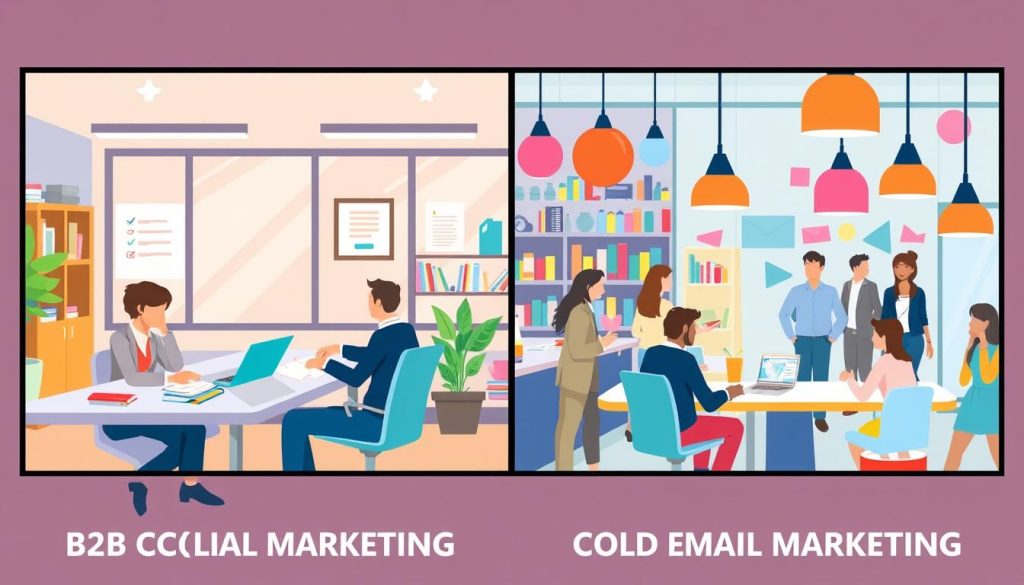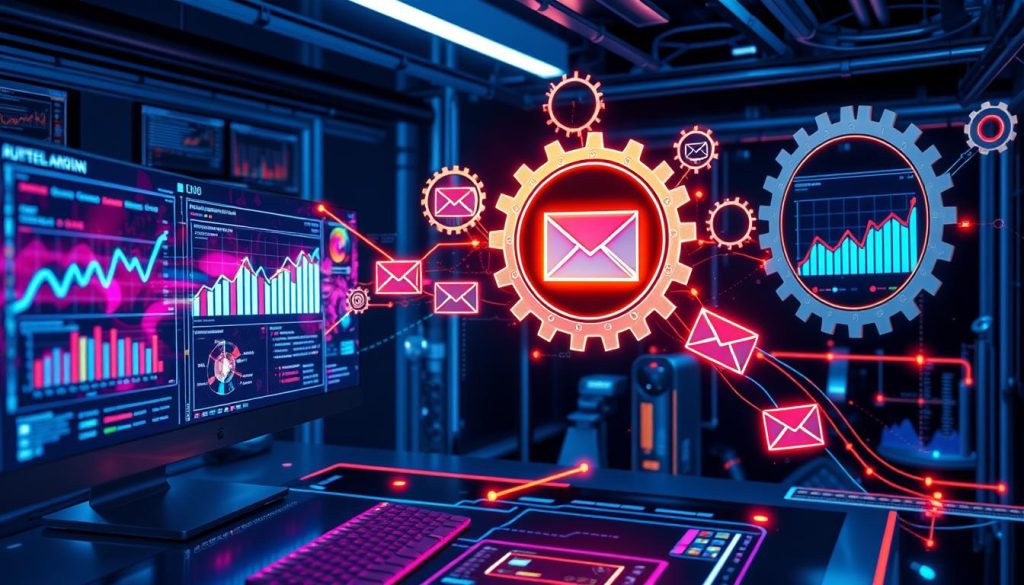In the world of digital marketing, knowing the difference between B2B and B2C email campaigns is key. Both aim to engage and convert their audiences, but they use different strategies. The tactics and best practices vary a lot.
This article dives into the main differences and best practices for cold email marketing in B2B and B2C. By grasping the unique challenges and opportunities in each market, businesses can make their email campaigns more effective. This leads to better lead generation, customer acquisition, and marketing success.
Key Takeaways
- Understand the fundamental differences between B2B and B2C email marketing approaches.
- Craft compelling subject lines that resonate with your target audience, whether it’s businesses or consumers.
- Leverage personalized outreach and targeted segmentation to enhance engagement and conversions.
- Navigate privacy regulations and opt-in processes to ensure compliance and build trust with your audience.
- Utilize email automation and data-driven strategies to optimize your campaigns and measure success.
Understanding the Fundamental Distinctions
Email marketing for B2B and B2C campaigns differs a lot. B2B focuses on solving business problems with longer sales cycles. B2C, on the other hand, is more about meeting personal needs with a quicker sales cycle.
Business-to-Business (B2B) Email Marketing
B2B email campaigns target business leaders. They look for ways to improve their operations and grow revenue. So, B2B emails focus on the benefits and how they solve problems.
Business-to-Consumer (B2C) Email Marketing
B2C email marketing is all about individual consumers. It aims to tap into their interests and needs. These campaigns are more about lifestyle and convenience, aiming for quick decisions.
| B2B Email Marketing | B2C Email Marketing |
|---|---|
| Longer sales cycle | Shorter sales cycle |
| Complex decision-making process | More impulsive decision-making |
| Focus on solving business problems | Focus on personal needs and emotions |
| Analytical and problem-solving approach | Emphasis on lifestyle and aspirations |
| Targeting business decision-makers | Targeting individual consumers |
Knowing the differences between B2B and B2C email marketing is key. It helps create strategies that speak to the right audience. This leads to better sales and more successful purchases.
Crafting Effective Subject Lines for B2B and B2C Campaigns
The subject line is key in email marketing. It decides if your audience will open your email. Whether you’re targeting businesses or consumers, great subject lines are crucial.
For B2B emails, focus on personalization and solving problems. Use the recipient’s name or company to make it personal. Also, show how your product can solve their challenges.
B2C emails aim to grab attention and create urgency. Use exciting language like exclusive offers or sneak peeks. Keep it short, clear, and catchy.
- Personalize B2B subject lines with the recipient’s name or company
- Highlight how your solution can solve a specific problem or challenge
- Create a sense of curiosity and urgency in B2C subject lines
- Keep subject lines concise and clear to capture attention
Mastering subject line optimization boosts your email open rates. It also leads to more engagement with your audience.
“The subject line is the most important part of an email – it’s the first thing people see and the deciding factor on whether they’ll open it or not.” – Neil Patel, Digital Marketing Expert
Personalized Outreach: A Crucial Strategy
In B2B email marketing, personalization is key. It helps build strong relationships and drive lead generation. By using customer data and insights, businesses can create emails that really speak to their audience.
Personalizing B2B Email Campaigns
Personalized email outreach is a game-changer for B2B marketers. It lets them understand and meet their customers’ needs. This builds trust and can lead to more conversions and loyal customers.
To make B2B email campaigns personal, marketers should:
- Use buyer personas to segment their audience and create targeted content
- Understand their target’s challenges, preferences, and communication styles with customer insights
- Add personalized elements like names and job titles to make emails feel more tailored
- Make sure the email content matches the recipient’s stage in the buying journey for better relevance
By focusing on personalized email outreach, B2B businesses can improve their customer relationships. This leads to better engagement and results in lead generation and conversions.
“Personalization is not just a nice-to-have; it’s a must-have in today’s competitive B2B landscape. Customers expect relevance, and businesses that deliver it will gain a distinct advantage.”
| Key Benefit | Impact |
|---|---|
| Improved Relevance | Personalized emails are more likely to capture the recipient’s attention and resonate with their specific needs and interests. |
| Enhanced Engagement | Personalized outreach leads to higher open rates, click-through rates, and overall engagement with the email content. |
| Stronger Relationships | By demonstrating a deep understanding of the customer, personalized emails help build trust and foster long-term customer loyalty. |
Cold Email Marketing for B2B vs. B2C: Key Differences and Best Practices
Cold email marketing needs a special touch, especially for B2B and B2C. Knowing the differences helps in getting better at lead generation and customer acquisition.
The main difference is in the sales cycle. B2B buyers take longer to decide, involving many people and detailed checks. B2C buyers make quicker decisions, based on their personal needs.
Creating a strong value proposition and clear call-to-action is key for both B2B and B2C. But, the details matter. B2B emails focus on what your product can do for a business. B2C emails aim to connect with the consumer’s lifestyle and feelings.
| Factor | B2B Cold Email | B2C Cold Email |
|---|---|---|
| Sales Cycle | Longer, more complex | Shorter, more independent |
| Buyer Motivations | Functional benefits, cost-savings, productivity | Emotional, lifestyle-enhancing |
| Value Proposition | Highlight business-centric advantages | Emphasize personal, consumer-focused appeal |
| Call-to-Action | Encourage further engagement, schedule a demo | Invite immediate purchase or trial |
By understanding these differences, businesses can improve their cold email marketing. This leads to better engagement with both B2B and B2C audiences.

Navigating Privacy Regulations and Opt-In Processes
Email marketing rules have changed a lot in the digital world. The European Union’s General Data Protection Regulation (GDPR) has raised the bar for data privacy. Now, businesses everywhere are dealing with email marketing rules, getting people to opt-in, and managing consent.
GDPR and Other Compliance Considerations
The GDPR has changed how we do email marketing. It’s now key to get clear consent from people who want to get emails. Companies must make sure their email sign-up is clear and follows the rules, telling people how their data will be used.
- Make sure your email sign-up follows GDPR rules, so people know what they’re agreeing to.
- Check your email list often to make sure everyone has given you permission to email them.
- Create detailed data privacy policies that explain how you handle people’s personal info.
But it’s not just the GDPR. Businesses also have to follow other rules like the CAN-SPAM Act in the U.S. and PIPEDA in Canada. Staying up to date with these rules is key to keeping your audience’s trust and protecting your email marketing.
“Earning and maintaining the trust of your email subscribers is essential for the long-term success of your email marketing campaigns. Ensuring compliance with privacy regulations is a critical step in that process.”
By focusing on email marketing regulations, GDPR compliance, and good opt-in processes, businesses can handle the complex world of data privacy and consent management. This helps build strong relationships with your audience and leads to successful email marketing.
Leveraging Email Automation and Segmentation
Email marketing uses automation and segmentation to boost results. These tools help send more personalized messages. They also help nurture leads and improve email marketing efforts.
Email automation makes tasks like welcome messages and reminders easier. It saves time and gives a consistent experience to subscribers. Automated workflows send messages based on user actions, keeping them interested.
List segmentation divides your list into smaller groups. These groups are based on demographics, interests, or purchase history. This way, you can send content that really speaks to each group, leading to better results.
- Leverage email automation to streamline your marketing efforts and deliver timely, personalized messages.
- Segment your email list to create targeted campaigns that cater to the specific needs and preferences of your subscribers.
- Use data-driven insights to optimize your email automation and segmentation strategies, continuously improving your campaign performance.
“Email automation and segmentation are the keys to unlocking the true potential of your email marketing campaigns. By leveraging these powerful tools, you can truly personalize your outreach and drive meaningful engagement with your audience.”
Adding email automation and segmentation to your strategy can change the game. It automates tasks and sends personalized content. This helps nurture leads, increase loyalty, and boost your email marketing’s impact.

Measuring Success: Essential Engagement Metrics
It’s vital to track the right email marketing metrics to see how well your campaigns are doing. Whether you’re focusing on B2B or B2C, knowing the key engagement KPIs is crucial. It helps you improve your strategy and get better results.
Key Performance Indicators (KPIs) for B2B and B2C
When evaluating your email marketing campaigns, consider these essential KPIs:
- Open Rates: This metric shows how many people open your emails. It tells you if your subject lines and content are working well.
- Click-Through Rates (CTR): This tracks how many people click on links in your emails. It shows how interested they are in what you’re offering.
- Conversion Rates: This measures how many people take the action you want them to. It shows the impact of your B2B or B2C campaigns.
- Unsubscribe Rates: Watching how many people choose to stop receiving your emails can tell you about your content’s relevance.
By keeping an eye on these engagement KPIs, you can get valuable data-driven insights. These insights help you make your email marketing campaigns better and improve your overall strategy.
| Metric | B2B | B2C |
|---|---|---|
| Open Rate | 15-25% | 20-30% |
| Click-Through Rate | 2-5% | 3-7% |
| Conversion Rate | 1-3% | 2-5% |
| Unsubscribe Rate | 0.1-0.5% | 0.2-1% |
The data-driven insights from these email marketing metrics can refine your B2B and B2C strategies. This ensures you get the most out of your engagement KPIs and reach your campaign goals.
“Measuring the right engagement KPIs is the key to unlocking data-driven insights that will drive the success of your email marketing campaigns.”
Industry-Specific Tactics and Case Studies
In industry-specific email marketing, the key is to tailor your strategies to your audience’s needs. By looking at case studies and best practices, businesses can learn to create their own campaign examples and engagement strategies.
In finance, email personalization is key to building trust and lasting relationships. A top investment firm used personalized subject lines and content. They saw a 45% open rate and 18% click-through rate.
In healthcare, where patient engagement is critical, a medical device maker focused on educational content. Their targeted campaigns led to a 30% increase in sales and higher customer loyalty.
Understanding your industry’s specifics and tailoring your email marketing can lead to better engagement. This can drive real business results.
“The key to successful industry-specific email marketing lies in the ability to anticipate and cater to the unique needs and preferences of your target audience. By leveraging data-driven insights and best practices, businesses can craft campaigns that truly make a lasting impact.”
Exploring industry-specific email marketing means finding a balance between strategy and understanding your market. This approach can lead to deeper engagement and better business results.
Best Practices for B2B Email Marketing
Creating effective B2B email marketing campaigns is key for sales and lead generation. By using best practices, businesses can better reach decision-makers. This makes a big difference in connecting with them.
Develop a Compelling Value Proposition
A strong value proposition is the base of a good B2B email campaign. Clearly state the benefits of your product or service. Explain how it solves problems for your audience. Keep it simple and focus on the practical benefits.
Create a Strong Call-to-Action
Every B2B email needs a clear call-to-action (CTA). It could be to schedule a demo, download a whitepaper, or ask for a consultation. Your CTA should lead the recipient to the next step in the sales process.
Craft a Targeted Content Strategy
Good B2B email marketing starts with a content strategy that speaks to your audience. Segment your lists and tailor your messages to each buyer persona. Offer valuable, educational content that shows your brand’s expertise.
| B2B Email Marketing Best Practices | Key Benefits |
|---|---|
| Develop a Compelling Value Proposition | Clearly communicates the unique value you offer, differentiating your brand and attracting the right leads |
| Create a Strong Call-to-Action | Guides the recipient toward the next step in the sales process, driving conversions and pipeline growth |
| Craft a Targeted Content Strategy | Positions your brand as a trusted industry authority, building rapport and nurturing leads |
By following these best practices, you can improve your B2B email marketing. This leads to better sales prospecting and lead generation. It helps your business succeed.
Conclusion
We’ve looked into the big differences between B2B and B2C email marketing. We’ve talked about how to make great subject lines and use personalized emails. We also covered how to follow privacy rules.
Success comes from knowing the unique needs of each area. By creating strategies that fit each audience, businesses can do well. They can get more leads, attract customers, and make their email campaigns better.
The future of email marketing is exciting. It will rely on using automation, segmenting, and data. Businesses that keep up with these trends will do great. They’ll use email to its fullest potential in a competitive world.
FAQ
What are the key differences between B2B and B2C email marketing?
B2B email marketing targets business professionals and focuses on solving business problems. It has longer sales cycles. On the other hand, B2C email marketing is for consumers, has shorter sales cycles, and focuses on personal needs and emotions.
How can I craft effective subject lines for B2B and B2C email campaigns?
For B2B, use problem-solving language and personalization in your subject lines. Create a sense of urgency or curiosity. For B2C, appeal to emotions and use personalization. Consider creating a sense of scarcity or exclusivity.
Why is personalized outreach crucial for successful email marketing?
Personalized outreach is key for B2B email marketing. Use customer data and insights to create relevant content. This builds stronger relationships and boosts engagement and conversions.
How do I navigate privacy regulations and opt-in processes for email marketing?
It’s vital to understand and follow email marketing regulations like GDPR. Obtain explicit consent and manage opt-in processes. This builds trust and keeps your campaigns ethical.
What are the key engagement metrics I should be tracking for B2B and B2C email marketing?
Track open rates, click-through rates, and conversion rates for both B2B and B2C. These metrics help you see how well your campaigns are doing. Use this data to improve your email marketing.
How can I leverage industry-specific tactics and case studies to improve my email marketing?
Look at industry-specific tactics and case studies for inspiration. They show how to tailor your campaigns to your audience. This can help you personalize your outreach and get better results.
What are the best practices for B2B email marketing, particularly for sales prospecting and lead generation?
For B2B email marketing, focus on a compelling value proposition and a clear call-to-action. Develop content that speaks to B2B decision-makers. These practices can help improve your B2B email campaigns.


